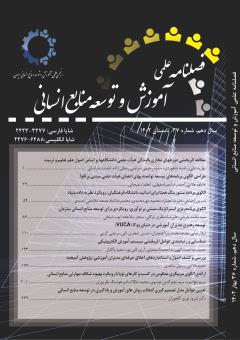تعیین عوامل مدل تصمیم گیری انتخاب روش های آموزش و یادگیری در توسعه منابع انسانی
محورهای موضوعی : روش های نوین آموزش وتوسعه منابع انسانی
1 - استادیار گروه علوم تربیتی، دانشکده علوم انسانی، دانشگاه بوعلی سینا، همدان، ایران
کلید واژه: آموزش و توسعه, روش های توسعه شایستگی, وزن دهی با روش AHP, تصمیم گیری.,
چکیده مقاله :
ارائه یک راهنمای عملیاتی برای انتخاب و به کارگیری روش های یادگیری در سازمان ها به عنوان یکی از ابزارهای مورد استفاده مدیران و کارشناسان آموزش در انتقال موثر آموزشی و ارتقاء بهینه فرآیندهای آموزش تأثیر ارزنده ای دارد. خلأ مدل نظری در این زمینه و تقاضای روز افزون سازمان ها برای تصمیم گیری در سازمان ها، انگیزه اصلی نویسنده جهت پژوهش و بسط شده است. رویکرد پژوهشی مورد استفاده در این پژوهش آمیخته می باشد. در بخش کیفی پژوهش برای مدل سازی نظری از روش پژوهش نظریه ای بهره گرفته شده است و در بخش کمی از روش پیمایش استفاده گردید. در بخش کیفی پس از انتخاب متخصصین از میان مدیران و کارشناسان آموزش به صورت هدفمند (از نوع گلوله برفی) تلاش شده با استفاده از روش نیمه ساختار یافته عوامل اصلی مدل تصمیم گیری تعیین شود. مشارکت کنندگان در این بخش 12 نفر از متخصصین بودند و نتایج پژوهش بخش کیفی با روش تحلیل مضمون استخراج گردید برای بخش کمی با استفاده از روش پیمایشی، ابتدا روایی سوالات با روش CVR مورد تأیید متخصصین قرار گرفت و بعد از توزیع و گردآوری آن ها با استفاده از آزمون های کولموگروف- اسمیرنوف، آزمون T و شاخص های مرکزی مورد تحلیل قرار گرفت و بعد از آن عوامل موثر در تعیین روش های آموزش و توسعه منابع انسانی تعیین شد و برای وزن دهی به آن ها تحلیل سلسله مراتبی (AHP) و نرم افزار Expert choice استفاده شد. عوامل موثر بعد ازشناسایی با ضریب وزنی شامل سطح مخاطبین (0.161)، دامنه برنامه توسعه شایستگی (0.162)، سطح پوشش دهی شایستگی (0.139)، هدف توسعه شایستگی (0.044)، میزان هزینه تخصیص برای توسعه شایستگی (0.284)، مدت زمان مطلوب توسعه شایستگی (0.067)، امکان تجربه واقعی پدیده های شایستگی توسط فراگیر(0.076) و مدت زمان انتقال یادگیری مطلوب (0.064) می باشند.
Providing an operational guide for the selection and implementation of learning methods in organizations as one of the tools used by managers and training professionals has a significant impact in effective knowledge transfer and optimal improvement of educational processes. The theoretical model gap in this area and the increasing demand of organizations for decision-making are the main motivations for the author's research. For its theoretical model, this mixed research employed a theoretical research method in the qualitative section and a survey method in the quantitative section. In the qualitative section, after purposeful selection of experts from among managers and training professionals (using a snowball sampling method), the main factors influencing decision-making models were determined using a semi-structured approach. The participants in this section included twelve experts, and the results of the qualitative research section were extracted using thematic analysis. For the quantitative section, the validity of the questions was first confirmed by experts using the CVR method. Following the distribution and collection of questionnaires, they were analyzed using the Kolmogorov-Smirnov test, T-test, and central indices. Afterwards, the influential factors in determining training methods and human resource development were identified. Analytical Hierarchy Process (AHP) and Expert Choice software were used for weighting these factors. The influential factors, after identification with their weight coefficients, include Audience Level (0.161), Competency Development Program Scope (0.162), Competency Coverage Level (0.139), Competency Development Objective (0.044), Cost Allocation for Competency Development (0.284), Desired Competency Development Duration (0.067), Feasibility of Learner's Real Experience with Competency Phenomena (0.076), and Desired Learning Transfer Duration (0.064). To make the findings practical and direct their practical application, the results were presented in the form of fully functional decision-making software that aims to empower the organization in decision-making.
1. Mulyadi M, Manalu NC, Fadillah AH, Hamta F. Effects of Job Stress, Work Culture and Against the Performance of Lecturers and Work Associations as Intervening Variables at the University of Ibnu Sina. InIAIC International Conference Series 2021 Jan 27 (Vol. 3, No. 2, pp. 83-89).
2. Nwafor S. Training and Development: Strategic Impact on Employees’ Job Performances. African Journal of Management and Business Research. 2022 Jul 31;5(1):50-60.
3. Udai Pareek & Roy P. Lynton (2000), Training for Organisational Transformation, Part-2 Sage Publication, N.D
4. Ei, K.M., 2023. The Effect of Core Banking Training Pratices on Employee Performance at Ayeyarwady Bank (Doctoral dissertation, MERAL Portal).
5. Mendoza CN, Bautista PD. Scenario-Based Training and Development Design among the Philippine Local Government Units. Texas Journal of Philology, Culture and History. 2022 Mar 21;4:8-24.
6. Braun, V., & Clark, V. Using thematic analysis in psychology. Qualitative in psychology.2006; 3(2): 77-101.


